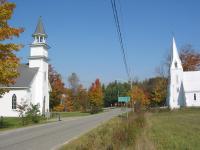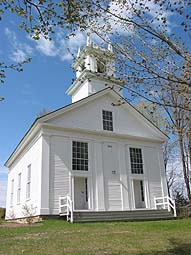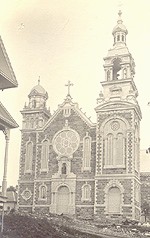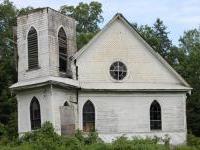 Visitors to the Eastern Townships are often struck by the number of churches they find. Indeed, it is not uncommon to find three or four, even five churches, of different denominations within close proximity to one another in a single village. In some cases, such as in Way's Mills, they stare at one another from opposite sides of the street.
Visitors to the Eastern Townships are often struck by the number of churches they find. Indeed, it is not uncommon to find three or four, even five churches, of different denominations within close proximity to one another in a single village. In some cases, such as in Way's Mills, they stare at one another from opposite sides of the street.
At one time, for example, five churches -- all clapboard, all white -- lined Main Street in Beebe Plain, where the Baptists, Anglicans, Methodists, Adventists and Roman Catholics all vied for their share of the faithful.
Enthusiasts of the back roads are surprised to discover churches at the loneliest of crossroads, seemingly in the middle of nowhere. They soon realize, however, that that picturesque little church may be all that remains of a once thriving community.
 NEW ENGLAND INFLUENCE
NEW ENGLAND INFLUENCE
The older churches in the Townships are strongly reminiscent of New England. This is so for good reason, since it was during the first waves of settlement (c.1810s-1840s) that organized religion first took root in the region. Settlers from south of the border - in particular New Hampshire, Vermont, and Massachusetts - brought with them their faiths, and their architecture. The Universalist Church in Huntingville, for example, looks like it was transplanted from somewhere in New England. It dates to 1844.
PROTESTANT DENOMINATIONS
At first, the Eastern Townships, especially the region along the border, were
served by itinerant preachers. Baptists, Methodists, Universalists, Congregationalists, and later Adventists all played a role in bringing God to the new settlements.** Evangelist ministers would hold meetings wherever it was convenient and wherever a sufficient number of followers could gather to hear the Word. Often this meant meeting in someone's home. In time, as communities took root, permanent places of worship, typically fairly plain in design and adornment, and usually made of wood, were built.
The "established" Protestant denominations -- the Church of England (Anglican) and, to a lesser extent, the Church Scotland (Presbyterian) -- began to flourish really only after the arrival of significant numbers of immigrants from Great Britain in the 1830s and 1840s. Unlike other denominations, the Anglicans benefited from government support. St. Peter's in Cookshire is one of the more picturesque Anglican churches in the Townships. It was built in 1868 and is unusual in that it is built of fieldstone.
 THE CATHOLIC CHURCH
THE CATHOLIC CHURCH
With the arrival of large numbers of French Canadians in the second half of the 19th century, and the colonization of large tracts of land in the northern and eastern parts of the Eastern Townships, the Roman Catholic Church began to make inroads in the region. By the early 20th century, most of the larger towns had a Catholic church and corresponding Catholic parish. More often than not, the Catholic church was the tallest building in town. And unlike most of the more modest Protestant churches, many of the Catholic churches were built in brick or stone. Some, like the church in Tingwick, are quite elaborate. Of course, in the newer French Canadian settlements there were only Catholic churches.
DWINDLING CONGREGATIONS
The importance of religion in the daily lives of Townshippers has declined as it has elsewhere in North America. As a result, many congregations are finding it difficult to survive. This is true both of the Catholic and the various Protestant (largely English-speaking) denominations. In the case of the English-speaking community, out-migration, assimilation, an aging population, low attendance rates, and rising costs associated with maintaining church property have forced the closure of many small churches. In some towns and rural areas, the number of parishioners has fallen so low that services are held only occasionally -- in some cases once or twice a year. Added to this is the difficulty (and expense) of finding ministers to serve these small communities. Yet, many churches have managed to survive, preserving their original vocation, albeit some with precariously small congregations and only occasional services.
 FORMER CHURCHES
FORMER CHURCHES
Many of the churches that have closed have been sold off and converted to other uses. They now serve as community centres, concert halls, town halls, even private homes, like the former United Church at Farnam's Corners. Some, like the former United Church in Tomifobia, have fallen into decay, a sign of a no longer viable community.
Taken as a whole, these churches -- and former churches -- represent an important part of our architectural heritage, and an integral part of our physical landscape.
*Note: In the 1920s, Canadian Methodists, Congregationalists and Presbyterians (at least some of them) joined to form the United Church of Canada.